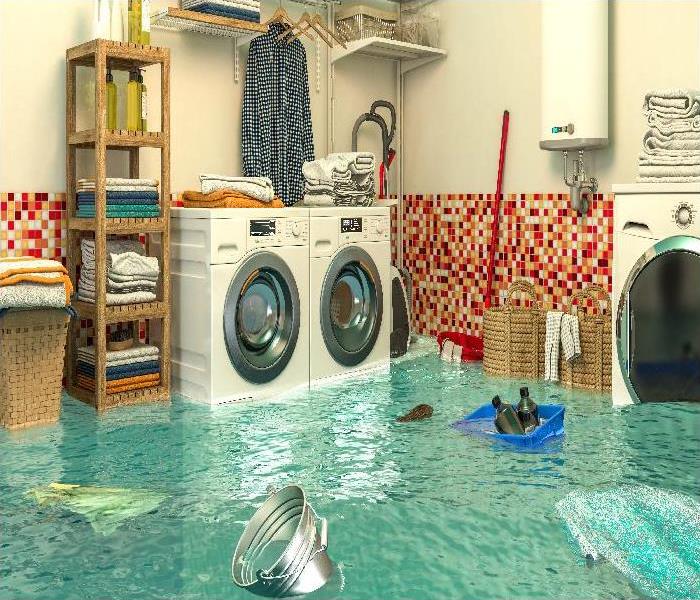What Are the Main Threats of Flash Flooding in Atlantic City?
7/11/2020 (Permalink)
 Our SERVPRO of Atlantic City / Hamilton / Hammonton team can respond quickly to these emergencies to make it “Like it never even happened.”
Our SERVPRO of Atlantic City / Hamilton / Hammonton team can respond quickly to these emergencies to make it “Like it never even happened.”
Flooding in Atlantic City
When your home falls victim to migrating floodwater, there are several immediate concerns for the property that professional restorers should address.
Flash flooding can result from some specific conditions, but because of its frequency in New Jersey, it has become a known threat to Atlantic City structures and homes. Preparedness for these emergencies means developing a plan that determines how your household gets protected and who is responsible for the restoration and recovery of the property from its earliest stages. Flooding can only damage a home more and more, so the faster you secure and dispatch experienced professionals to the house, the better able to protect its materials and contents you become.
As one of the most populated cities in Atlantic County, when flood damage impacts Atlantic City, hundreds of properties are often involved in the disaster. Because we are part of a large loss recovery team, we can pool resources, personnel, and experience with other sister franchises to help during these emergencies. This response reduces the devastation to structures and allows our technicians to control widespread threats that can overtake the entire property.
How Fast Can My Home Get Overwhelmed with Flash Flooding?
The pace and immediate force of flash flooding are some of its most dangerous qualities. While this can be threatening enough to those exposed to the disaster, this faster pace and strength of the water can also lead to many other compromising conditions. How your home gets cleaned and mitigated in these earliest stages can set the expectancy for how much of the property is actually restorable. As with every natural flooding scenario that our professionals face, there are specific conditions that we must expect with flash flooding entering a residence. These include:
• Standing Water – In flash flooding scenarios, standing water in the home could be as much as several feet. We must extract pooled water to the surface to begin cleaning and restoring the property.
• Structural Damage – The exposure of sensitive materials is inevitable. The longer that restoration takes to start, the more of these construction materials that become too deteriorated or compromised to restore.
• Debris – Water entering the home can come with animals, mud, silt, debris, and other potential concerns.
• Contaminants – Natural flooding must get considered to be a Category 3 loss event with contaminated blackwater. There is a high probability that moving water has overwhelmed sanitary sewers and presented other high-contamination risks now circulating in the water.
Why Is Extraction One of the First Steps in Restoration?
Extraction is one of the first steps taken after a flood loss, specifically because of the challenges present in restoration and cleaning without removing standing water. Surface damage like pooling water can continually absorb into surfaces and cause irreparable damage. We have multiple tools to address these concerns in our inventory. Part of choosing the right tool means identifying any debris and solids that might exist in the standing water. Natural flooding can carry in silt, mud, and other debris. Several extractors cannot move solids, so we must choose the right tool as soon as we arrive. With the commonality of water damages and flooding, we keep these extractors pre-stocked and ready to mobilize:
• Submersible Pumps
• Trash Pumps
• Wet Vacuums
• Weighted Extractors
When Can Repairs Occur?
Few flash flooding instances impact area homes without the need for some degree of controlled demolition, build back, or repair. Our SERVPRO professionals have a dedicated team of residential contractors in-house that can help to resolve these situations with fast actions. After a flood, several immediate emergency services must occur, and that is where our experienced contractors begin. These actions include:
• Board Up – Structural breaches allow for more water penetration and other threats. Board up seals these openings to prevent further water flow.
• Tarping – Roofs can also become damaged during violent storms, leaving the property vulnerable in similar ways. We can tarp over these vulnerabilities until the appropriate repairs take place.
• Tree Removal – The force of flash flooding can uproot and knock over trees. When these land on your house or property, our team must work quickly to remove it.
• Controlled Demolition – By only removing the portions of drywall and other structural materials that are too damaged to preserve, we can make build back more efficient and ultimately more cost-effective.
Restoring your home after a flash flood can be a challenge, especially with the high degree of damage that often results. Our SERVPRO of Atlantic City / Hamilton / Hammonton team can respond quickly to these emergencies to make it “Like it never even happened.” Give us a call anytime at (609) 965-0885.





 24/7 Emergency Service
24/7 Emergency Service